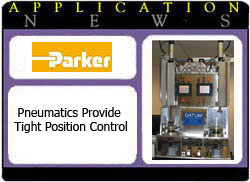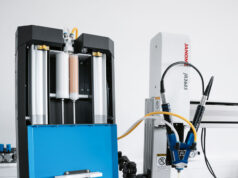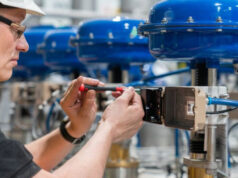by Andrew McCarty, Parker Hannifin Corporation
Spinal cord injury (SCI) has potentially devastating consequences. As of June 2006, over 253,000 people in the U.S. had structural or functional issues related to spinal cord injuries. Evaluation of spinal implant devices requires testing systems that can replicate the complex motions and loads human joints commonly undergo. Continually improving equipment that can perform tests of strength, range-of-motion, and endurance contributes to breakthroughs in the treatment of SCI patients.
The Datum Spinal Joint Endurance Testing Machine – recently designed and built by Datum Industrial Design, Inc., North Bergen, New Jersey – evaluates how spinal joints will function in human bodies. The machine can be programmed for specific operating parameters so that it can test a variety of spinal joints in a range of scenarios.
 The machine demanded tight force or position control, but its loads did not justify hydraulics. Typically, the alternative would be to use an electromechanical solution, such as servomotors, to set-up and change parameters for different tests. However, Datum needed a system that could be designed and manufactured quickly and easily, and that would require minimal maintenance. What’s more, the machine itself had to easily and quickly set-up and change testing parameters. Datum’s engineering team decided that cylinders and valves were the most suitable choice for the job.
The machine demanded tight force or position control, but its loads did not justify hydraulics. Typically, the alternative would be to use an electromechanical solution, such as servomotors, to set-up and change parameters for different tests. However, Datum needed a system that could be designed and manufactured quickly and easily, and that would require minimal maintenance. What’s more, the machine itself had to easily and quickly set-up and change testing parameters. Datum’s engineering team decided that cylinders and valves were the most suitable choice for the job.
The main requirement was to vary the air pressure of the cylinder to control pressure placed on the spinal implant joints during testing. Control had to be easy to establish and maintain without a large degree of fluctuation, so Datum contacted Progressive Hydraulics, Inc., and the company recommended a variable-pressure output valve controlled with an input voltage.
“The centerpiece of the system is the Parker P3P-R Series Regulator,” said Chris Shatteman, an engineer with PHI. Parker 050 inlet regulators control maximum input air pressure to the testing machine at 100 PSI. Electropneumatic regulators or input-to-pressure (I/P) valves use variable-voltage input signals, from 0 to 10 VDC, to set pressure. In this application, the P3P-R regulators control the air cylinder pressure from 7 to 100 PSI. For example, because inlet supply is set at 100 PSI, if a 5 VDC signal is sent from the P3P-R, pressure will be 50 PSI at the valve’s outlet.
A 6-in. diameter test tank controls tank rotation motion during test cycles.
It is mounted on a titanium base with a roller finger extending from the base plate. Each component is networked to a computer for data acquisition and analysis. The pressure is translated into downward force by the machine – in this case, 500 lb maximum and 25 lb minimum. An internal pressure transducer, mounted on the upper end of the push rod, controls the downward pressure. It generates a signal that combines with the input voltage signal to yield an appropriate drive voltage signal for the required pressure levels. “This closes the loop by producing excellent tolerance on valve outlet pressure,” Shatteman said.

Datum’s team further refined the spinal testing apparatus by deploying a load cell on the work piece itself. According to Shatteman, “The internal pressure transducer ensures accurate pressure control at the valve outlet, but that does not account for frictional forces, which can skew work piece accuracy.” Datum technicians installed a load cell with a range of 0 to 10 VDC (depending on load cell compression) between the work piece and cylinder rod end. The Parker P3P-R has an optional input sensor that accepts a signal from the load cell that does not completely depend upon the pressure transducer on the internal I/P interface. Because there is nothing in-between to generate additional error, extremely tight pressure tolerances on work piece load forces are possible. In addition, the downward-pushing cylinder is the only moving part, so the system requires little maintenance.
The pneumatic design used with the Joint Endurance Testing machine also eliminated the need to maintain ball-screw assemblies, and the air valves with electrical input for pressure control are user-friendly and easy to program. In addition, the pneumatic products can be adjusted or changed quickly, with few problems, which eliminates downtime.
Parker Hannifin Corp.
www.parker.com









